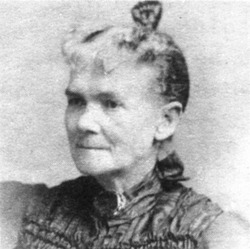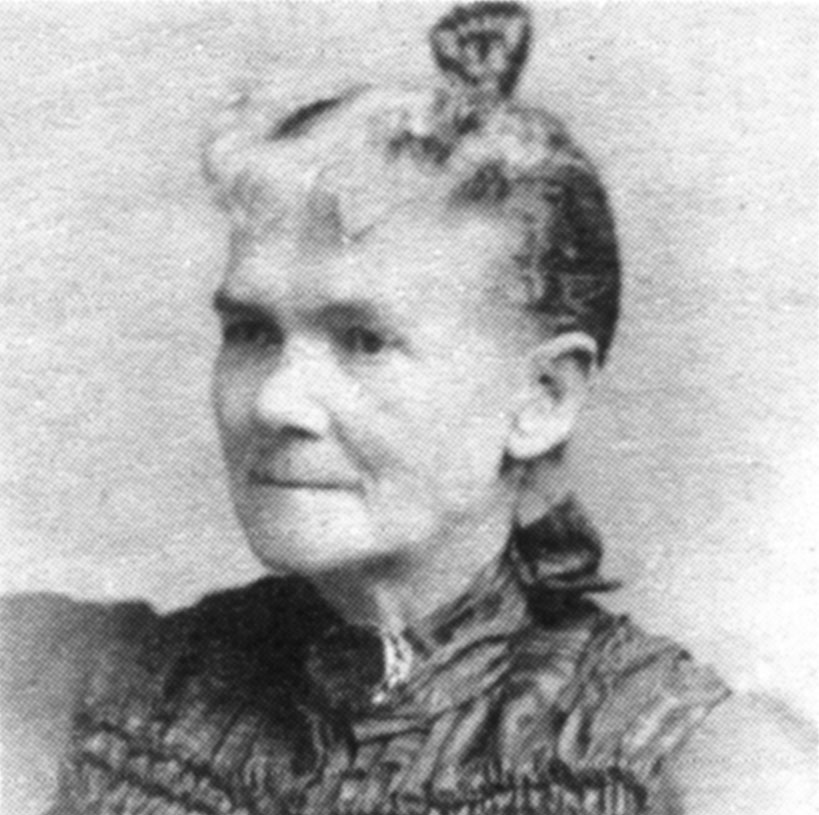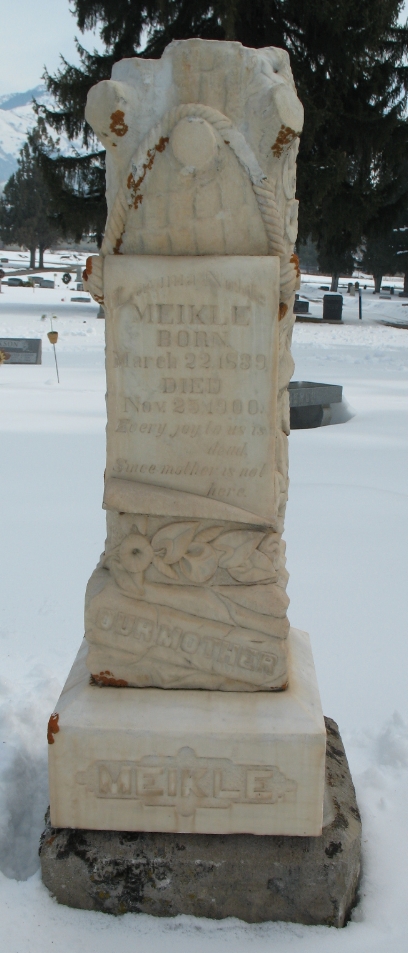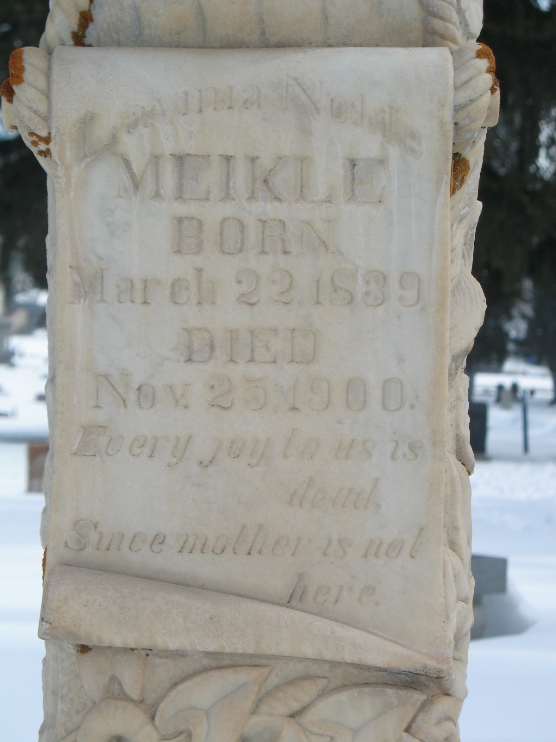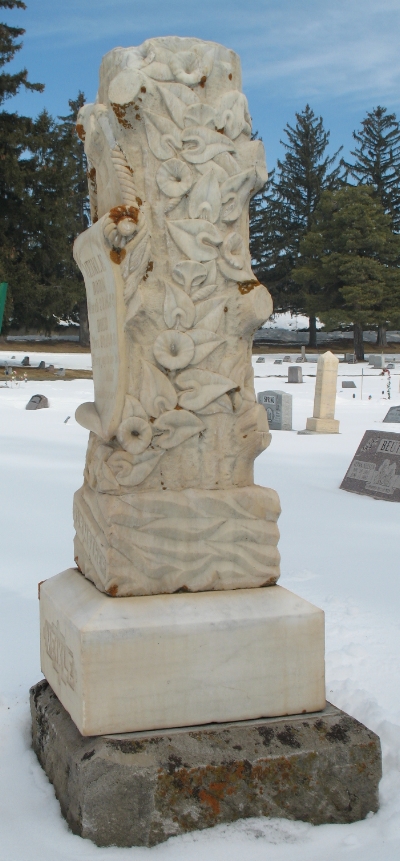Married Benjamin Burk Aiken, 6 Nov 1861, Smithfield, Cache, Utah, later divorced
Children - Surbina Almeda Aiken m. William Scrowther, Fanny Lazelle Aiken m. John Roberts, Rachael Mary Ann Aiken m. Edwin Huntsburry, Harper Waterhouse Aiken never married.
Married James Meikle, 17 Oct 1872
History - Lavinia sailed with her parents sailed on the ship William Tapascott" on May 11, 1860.
Waterhouse Harper, her brother, came to America in 22 Feb 1854 and Eliza Priscilla came in 20 Apr 1857. Eliza Priscilla and her husband Robert Leeming Fishburn were planning on being merchants so Priscilla's two sisters, LaVinia and Henrietta, came west earlier; the rest of the family came west with the next company. They lived in Williamsberg for two years to earn money to come west. Babysitting, housecleaning and taking in washing, were some of the things the women did to earn money.
While crossing the plains LaVinia became good friends with Amelia Folsom, Brigham Young's last wife. LaVinia said that she didn't have to walk too much because the young fellows would let them ride on their horses.
The family settled in Smithfield. Her brother Aquilla always rang the bell of the church, a long building built where the ''plow monument'' now stands south of the library. it was a long building with the stage on the west end.
LaVinia's first husband was Benjamin Burke Aiken; three girls and one boy were born to them. Benjamin Burke Aiken was a good man, born near Salem, Massachusetts, on 29 Feb 1829. The Aikens joined the Church around 1843 or 1844.
They crossed from Massachusetts to get some free ($1.25 an acre) land in New York, Indiana and Illinois, and came on from Nauvoo to Utah. Benjamin was a bodyguard for the prophet Joseph Smith. He also made trips across the plains to help others. In 1860 he came to Smithfield and built a log house on the east line of the Summit Fort. Three years later at the abandonment of the Fort, Ben moved across the road and built an adobe, two-room house.
She came to America in 1858 with her parents, a brother and six sisters, William Goodwin Noble, upon his arrival at New York was assigned to a two year missionary service at Wilmington, The children had to rustle jobs for the home budget. They came on to Smithfield in 1862 and that fall they all did gleaning (gathering wheat in the fields) that they might have food and clothing material. They did well.
Ben had his home ready to occupy on his marriage day. By that time Ben had acquired a few acres of good land, a team, a wagon, and a few cows. He was a good farmer and an excellent livestock manager. He grew up in an environment where waste was a sin and sensible economy a virtue. The Polka was not his choice of dance; the Blue Danube suited him in dance format. Benjamin Aiken loved his home, his wife and his four children. They were: Surbina Almeda, married William Scrowther; Fannie Lazelle, married John Roberts; Rachael Mary Ann, married Edwin Huntsberry; and Harper Waterhouse, who never married.
LaVinia later became the wife of James Jackson Meikle, He was a son of William and Margaret Jackson Meikle, and was born Hamilton, Scotland on July 5, 1839. His parents joined the Church of Jesus Christ of Latter-day Saints in 1848. His father William Meikle, died shortly after that event. James was baptized and confirmed a member of the Church on August 17, 1848, at the age nine.
James, his mother and sister Isabelle emigrated to Utah in 1856. They crossed the ocean on the "Enoch Train'' steam ship. They traveled the plains with the Captain McArthur Handcart Company arriving in Salt Lake City, Utah on September 29, 1856. Here he joined his brother, Robert, who had come to Utah in 1849 and got employment with the Jenning Tannery Company at Salt Lake City, Utah. The Meikle brothers worked for that company until 1860 when they came to Smithfield. They had taken advantage of their opportunity at the Jennings Tannery to thoroughly master the tanning process. In 1860 they began the building of a leather processing plant at Smithfield, and early in 1861 had the business well underway tanning out a good supply of excellent leather. Meikle brothers carried on a very successful leather processing plant for 15 years, but in 1874 they were pressured by other interests. Up to that time the leather processing business had expounded to a need for a contributing sideline industry, that of getting expanded quantities of calcifying rock to get more a better lime to use in the processing. The end product, of course continued to better leather. Those sidelines meant the employment of more people. The leather production in 1873 was 3300 hides valued at $11,300.
In 1875, the United Order at Smithfield set up a boot and shoe manufacturing plant that at one time employed ten men and women. The rock calcifying enterprise in itself became a valuable employment industry.
LaVinia had six daughters born to her during her second marriage. They were: LaVinia Priscilla Meikle, born in 1873, married James Kirby in 1898; Kate Violetta Meikle, born August 15, 1875, married Wickliff Anderson Ewing, June 15, 1904; Jessie Margaret, who died when she was 18 months old; Zelphia Meikle, born June 3, 1879, married Lindsay Lightfoot, January 12, 1899; Mamie Rebecca Meikle, born April 7, 1882, married Carl Nilson, June 5, 1902; Birdie Meikle, born September 11, 1884, married Frank Covey, September 1902.
LaVinia Noble Meikle was a kind, good homemaker. She gave great care to her children and was always very pleasant and personable. She had a great challenge to provide the needs and comfort for 10 children. She was a very good midwife and each summer she collected herbs of all kinds and dried them. When someone needed some medical aids she could mix a portion. People from all over Smithfield came for her medicine. They would bring a bottle filled with sugar as payment and she would empty out the sugar and fill the bottle with her remedy.
The following are a few of her remedies: Canker medicine was made by the bread pan full. She used Kinniekinic gathered from the mountains, wild grape root, raspberry bark and leaves, burnt alum sugar and much more. Salve for sores made from balm a Gillaird buds and lard or some powder. She also made cough medicine. Lavinia also pierced ears. Children even brought their broken toys, especially dolls to her to be repaired. She sang in the Noble choir and had a very sweet voice. She always had some dried corn nuts or something in her pocket to chew upon. She did everything. She carried a small cup with her so that she could get a drink of water whenever she passed a ditch.
LaVinia died when she was 65 of diabetes. LaVinia was buried in a plot in Smithfield Cemetery. It was one of the first with grass. Her daughters carried water from a block away to keep it green.
Pioneer History of Lavina Noble Aiken Meikle
Married Benjamin Burk Aiken, 6 Nov 1861, Smithfield, Cache, Utah, later divorced
Children - Surbina Almeda Aiken m. William Scrowther, Fanny Lazelle Aiken m. John Roberts, Rachael Mary Ann Aiken m. Edwin Huntsburry, Harper Waterhouse Aiken never married.
Married James Meikle, 17 Oct 1872
History - Lavinia sailed with her parents sailed on the ship William Tapascott" on May 11, 1860.
Waterhouse Harper, her brother, came to America in 22 Feb 1854 and Eliza Priscilla came in 20 Apr 1857. Eliza Priscilla and her husband Robert Leeming Fishburn were planning on being merchants so Priscilla's two sisters, LaVinia and Henrietta, came west earlier; the rest of the family came west with the next company. They lived in Williamsberg for two years to earn money to come west. Babysitting, housecleaning and taking in washing, were some of the things the women did to earn money.
While crossing the plains LaVinia became good friends with Amelia Folsom, Brigham Young's last wife. LaVinia said that she didn't have to walk too much because the young fellows would let them ride on their horses.
The family settled in Smithfield. Her brother Aquilla always rang the bell of the church, a long building built where the ''plow monument'' now stands south of the library. it was a long building with the stage on the west end.
LaVinia's first husband was Benjamin Burke Aiken; three girls and one boy were born to them. Benjamin Burke Aiken was a good man, born near Salem, Massachusetts, on 29 Feb 1829. The Aikens joined the Church around 1843 or 1844.
They crossed from Massachusetts to get some free ($1.25 an acre) land in New York, Indiana and Illinois, and came on from Nauvoo to Utah. Benjamin was a bodyguard for the prophet Joseph Smith. He also made trips across the plains to help others. In 1860 he came to Smithfield and built a log house on the east line of the Summit Fort. Three years later at the abandonment of the Fort, Ben moved across the road and built an adobe, two-room house.
She came to America in 1858 with her parents, a brother and six sisters, William Goodwin Noble, upon his arrival at New York was assigned to a two year missionary service at Wilmington, The children had to rustle jobs for the home budget. They came on to Smithfield in 1862 and that fall they all did gleaning (gathering wheat in the fields) that they might have food and clothing material. They did well.
Ben had his home ready to occupy on his marriage day. By that time Ben had acquired a few acres of good land, a team, a wagon, and a few cows. He was a good farmer and an excellent livestock manager. He grew up in an environment where waste was a sin and sensible economy a virtue. The Polka was not his choice of dance; the Blue Danube suited him in dance format. Benjamin Aiken loved his home, his wife and his four children. They were: Surbina Almeda, married William Scrowther; Fannie Lazelle, married John Roberts; Rachael Mary Ann, married Edwin Huntsberry; and Harper Waterhouse, who never married.
LaVinia later became the wife of James Jackson Meikle, He was a son of William and Margaret Jackson Meikle, and was born Hamilton, Scotland on July 5, 1839. His parents joined the Church of Jesus Christ of Latter-day Saints in 1848. His father William Meikle, died shortly after that event. James was baptized and confirmed a member of the Church on August 17, 1848, at the age nine.
James, his mother and sister Isabelle emigrated to Utah in 1856. They crossed the ocean on the "Enoch Train'' steam ship. They traveled the plains with the Captain McArthur Handcart Company arriving in Salt Lake City, Utah on September 29, 1856. Here he joined his brother, Robert, who had come to Utah in 1849 and got employment with the Jenning Tannery Company at Salt Lake City, Utah. The Meikle brothers worked for that company until 1860 when they came to Smithfield. They had taken advantage of their opportunity at the Jennings Tannery to thoroughly master the tanning process. In 1860 they began the building of a leather processing plant at Smithfield, and early in 1861 had the business well underway tanning out a good supply of excellent leather. Meikle brothers carried on a very successful leather processing plant for 15 years, but in 1874 they were pressured by other interests. Up to that time the leather processing business had expounded to a need for a contributing sideline industry, that of getting expanded quantities of calcifying rock to get more a better lime to use in the processing. The end product, of course continued to better leather. Those sidelines meant the employment of more people. The leather production in 1873 was 3300 hides valued at $11,300.
In 1875, the United Order at Smithfield set up a boot and shoe manufacturing plant that at one time employed ten men and women. The rock calcifying enterprise in itself became a valuable employment industry.
LaVinia had six daughters born to her during her second marriage. They were: LaVinia Priscilla Meikle, born in 1873, married James Kirby in 1898; Kate Violetta Meikle, born August 15, 1875, married Wickliff Anderson Ewing, June 15, 1904; Jessie Margaret, who died when she was 18 months old; Zelphia Meikle, born June 3, 1879, married Lindsay Lightfoot, January 12, 1899; Mamie Rebecca Meikle, born April 7, 1882, married Carl Nilson, June 5, 1902; Birdie Meikle, born September 11, 1884, married Frank Covey, September 1902.
LaVinia Noble Meikle was a kind, good homemaker. She gave great care to her children and was always very pleasant and personable. She had a great challenge to provide the needs and comfort for 10 children. She was a very good midwife and each summer she collected herbs of all kinds and dried them. When someone needed some medical aids she could mix a portion. People from all over Smithfield came for her medicine. They would bring a bottle filled with sugar as payment and she would empty out the sugar and fill the bottle with her remedy.
The following are a few of her remedies: Canker medicine was made by the bread pan full. She used Kinniekinic gathered from the mountains, wild grape root, raspberry bark and leaves, burnt alum sugar and much more. Salve for sores made from balm a Gillaird buds and lard or some powder. She also made cough medicine. Lavinia also pierced ears. Children even brought their broken toys, especially dolls to her to be repaired. She sang in the Noble choir and had a very sweet voice. She always had some dried corn nuts or something in her pocket to chew upon. She did everything. She carried a small cup with her so that she could get a drink of water whenever she passed a ditch.
LaVinia died when she was 65 of diabetes. LaVinia was buried in a plot in Smithfield Cemetery. It was one of the first with grass. Her daughters carried water from a block away to keep it green.
Pioneer History of Lavina Noble Aiken Meikle
Family Members
-
![]()
Jane Ann Noble Fox
1831–1919
-
Rachel Noble
1833–1833
-
![]()
Harper Waterhouse Noble
1834–1856
-
![]()
Eliza Priscilla Noble Fishburn
1836–1905
-
![]()
Henrietta Noble Gilbert
1837–1921
-
![]()
William Aquilla Noble
1841–1880
-
![]()
Louisa Rox Snow Noble Watts
1843–1876
-
![]()
Lenora Tryphena Noble Merrill
1846–1876
-
![]()
Zilpha Noble Raymond
1846–1923
-
![]()
Laura Matilda Noble Fishburn
1850–1929
-
![]()
Fanny Lazell Aiken Roberts
1862–1933
-
![]()
Sirbina Almeda Aiken Scrowther
1864–1947
-
![]()
Harper Benjamin Aiken
1866–1944
-
![]()
Mary Ann Rachel Aiken Huntzbery
1868–1923
-
![]()
Levina Priscilla Meikle Carver
1873–1942
-
![]()
Katie Violetta Meikle Ewing
1875–1968
-
![]()
Margaret Jesse Meikle
1877–1877
-
![]()
Zilphia Meikle Lightfoot
1878–1963
-
![]()
Mamie Rebecca Meikle Neilson
1882–1967
-
Birdie Meikle Covey
1883–1964
Sponsored by Ancestry
Advertisement
See more Aiken Meikle or Noble memorials in:
- Smithfield City Cemetery Aiken Meikle or Noble
- Smithfield Aiken Meikle or Noble
- Cache County Aiken Meikle or Noble
- Utah Aiken Meikle or Noble
- USA Aiken Meikle or Noble
- Find a Grave Aiken Meikle or Noble
Explore more
Sponsored by Ancestry
Advertisement
